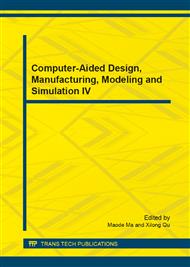p.957
p.962
p.966
p.971
p.976
p.981
p.985
p.991
p.996
Study on the Properties of SiC/Mullite Porous Ceramics Based on ANSYS Numerical Simulation
Abstract:
In this paper, we use foam injection coagulation method to fabricate SiC/mullite porous ceramic with porosity 38-80%. In order to study the performance of the ceramic, we use the principle of cavity to establish the fourteen surfaces model of the SiC/ mullite porous ceramics, and use the ANSYS finite element simulation software to simulate the performance of ceramic, and do simulation on the mechanical properties of the ceramics. In order to study the influence of different wall thickness and curvature on the properties of ceramics, we calculate the structure stress distribution of fourteen surfaces when wall thickness is 0.4 and 0.5mm. When the wall thickness is 0.2mm, we study the structure stress distribution with radius 0.1mm and 0.2mm. So we obtain the influence of wall thickness and curvature radius on the properties of porous ceramics. It provides valuable reference data for the study on porous ceramics.
Info:
Periodical:
Pages:
976-980
Citation:
Online since:
October 2014
Authors:
Price:
Сopyright:
© 2014 Trans Tech Publications Ltd. All Rights Reserved
Share:
Citation:


